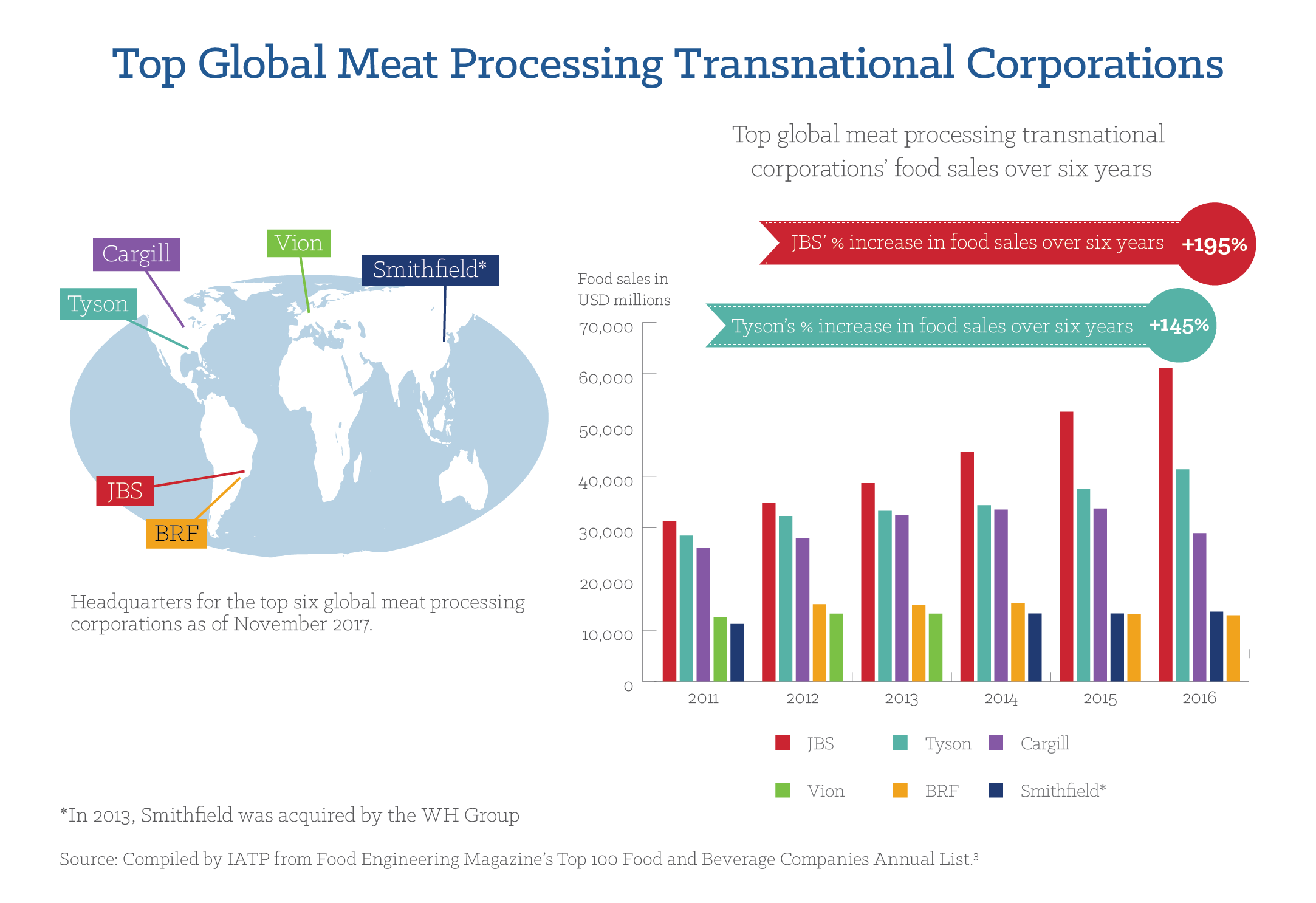Largest Beef Companies in the World
While global agribusiness giants such every bit Monsanto, Cargill, Bayer and DuPont are best known for their control over the global seeds, cereals and agrochemicals market, symbolizing the corporate takeover of the nutrient arrangement, an extremely powerful segment of agribusiness remains subconscious from public scrutiny: The companies that control the production, processing and trade of beef, poultry and pork worldwide. This is because they oftentimes hibernate backside a "make" proper noun for their products and because their stop product (meat) does not appear directly responsible for the negative impacts of the supply chain. Last November, IATP published inquiry showing that the top 20 meat and dairy companies, known as the "Meat Majors," produce more greenhouse gases than Germany. Fifty-fifty if the world were to eliminate the use of fossil fuels, unless over consumption of meat is eliminated and reduced to sustainable levels, the World is likely to face more than 2 degrees of global warming past 2050.
IATP defines the "Global Meat Complex" as a highly concentrated (horizontally and vertically), integrated web of transnational corporations (TNCs) that controls the inputs, production and processing of mass quantities of food animals. Some of these TNCs occupy all major parts of the global meat production value concatenation. For instance, Cargill is ane of the globe's leading grain traders, supplying grains for feed; the 2nd-largest feed manufacturer in the earth; and the third-largest meat processor (in food sales) in the earth. Others, like Thailand'south CP Group, China's New Promise Liuhe and Wen's Food Group or Brazil's BRF are the world's leading feed manufacturers and meat processing giants in their own right.
The ascension of this type of agribusiness has been phenomenal over the terminal forty years, but specially intense since the 2000s. JBS, Tyson Foods, Cargill and Smithfield are the world'due south largest meat-producing corporations. JBS lone deemed for over ten million tons (carcass weight equivalent) of meat processing in 2009-2010, surpassing the combined total of the globe's summit xi to twenty companies. Each of these companies has deployed a mix of similar main strategies: Mergers and acquisitions of other companies, vertical integration of their supply chains (including product diversification and/or wholesale retail), and successful lobbying of governments that in turn negotiate trade and investment deals that ease these companies' access to strange markets.

The Global Moving picture
The sheer power of these companies obscures the fact that only 9.7 percent of the meat produced in the earth is traded. Much of it is grown past modest producers and stays within the region.
Nonetheless, the top ten global meatpackers still dominate the whole sector. And, even amongst them, the top three (JBS, Tyson Foods and Cargill) have food sales that are double or triple that of number 4, Smithfield Foods (now owned by Chinese WH Group) and number v, BRF (formerly known every bit Brasil Foods). This concentration in buyers puts pressure on farmers to accept lower prices, while conforming to evermore burdensome requirements from the companies for what animals to enhance and how to enhance them.
The astounding ascent of these giants has been achieved with the explicit support of public funds from governments, through policies that permit these corporations to pollute country and water, and by governments absorbing the public health costs and risks generated by this industry. For instance, nearly 40 countries across Europe, Asia, Africa and North America have faced a new wave of highly-pathogenic bird flu since October 2016. It is decimating both wild and farmed bird populations—non only costing farmers and the public millions of dollars in mitigation, just, more importantly, increasing the chance of transfer to humans that has led to deaths in countries like China. In the U.s., dairy Bars Animal Feeding Operations (CAFOs) from Iowa to Alabama are receiving taxation breaks and subsidies while also being exempted from reporting their GhG emissions.
Despite the evidence that these companies are major contributors to climate change, they are not being held accountable for their emissions in whatever consistent way, leading with green-washed PR strategies. Cargill, for example, has fix a goal of v percent reduction in emissions intensity by 2020. However, reducing the intensity of emissions could be completely offset by their continued growth, leading to an increment in overall emissions. Our forthcoming report aims to debunk these claims of sustainability so that we can begin to hold the Meat Majors accountable. It is clear that the future of a good for you food arrangement depends on reigning in the power of these mighty giants.
If you've enjoyed this article and others like information technology, please consider making a contribution to support our work today. As a nonprofit, we rely on the generosity of our supporters to provide high-level enquiry and analysis on agriculture and trade policy.
richardsongolould.blogspot.com
Source: https://www.iatp.org/blog/leaders-global-meat-complex
0 Response to "Largest Beef Companies in the World"
Publicar un comentario